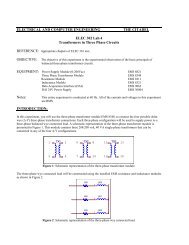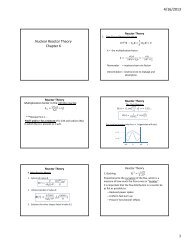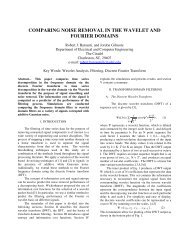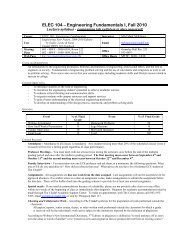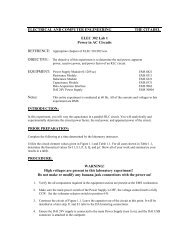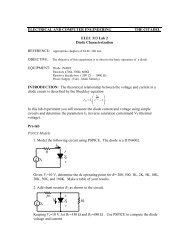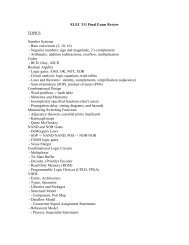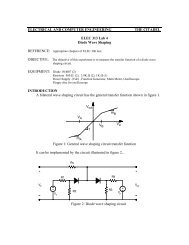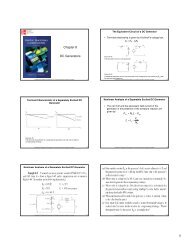You also want an ePaper? Increase the reach of your titles
YUMPU automatically turns print PDFs into web optimized ePapers that Google loves.
4/23/2013The Time Dependent <strong>Reactor</strong><strong>Nuclear</strong> <strong>Reactor</strong> <strong>Kinetics</strong><strong>Chapter</strong> 7• The previous chapter was concerned with criticalreactors operating at constant power levels. In anoperating reactor many factors can affect the valueof k resulting in a super critical or sub critical reactor.• These factors include– Fuel burn-up– Fission product formation– Moderator temperature changesThe Time Dependent <strong>Reactor</strong>II. Three time periods of interestA. Long time {days ->months}On this time scale we deal with variation in the coreneutron flux as a result of fuel depletion and the burn-up ofany pre-load poisons.For analysis purposes we assume the flux to changevery slowly with time and can treat the reactor flux asthough it is in a series of stationary states.The approaches is thus to solve the diffusionequation under new assumptions of fuel distribution andpoison loading.In terms of the six factor formula, the change in fueland poison can be accounted for by a change in the thermalutilization factor f .The Time Dependent <strong>Reactor</strong>B. Intermediate time {hours ->days}On this time scale we deal with variation in thecore neutron flux as a result of changing concentrationsof fission products and the associated radioactive decaychains. Several fission products are produced insignificant quantities and also have a large neutronabsorption cross sections.In terms of the six factor formula, the change infission product “poisons” can be accounted for by achange in the thermal utilization factor f .The Time Dependent <strong>Reactor</strong>B. Intermediate time {hours ->days}The most important fission product poison isxenon 135, which has the following decay process.Xe-135 has a large cross section for absorption and isproduced both from the above decay of Iodine and directlyfrom fission. Over time the Xe-135 disappears due to decayand also due to neutron absorption.The Time Dependent <strong>Reactor</strong>C. Short time{seconds -> minutes}These problems are typically encounteredwhen an action is taken that causes theconditions in the reactor to be perturbed. Themost common action is a temperature change asa result of an increase or decrease in the steamdemand from the steam supply system.1
4/23/2013The Time Dependent <strong>Reactor</strong>III. <strong>Reactor</strong> <strong>Kinetics</strong>a. Prompt neutrons and Delayed neutrons.Recall that nearly all (99.3%) neutrons emittedin fission occur instantly, at the moment offission. These are prompt neutrons.A small fraction of the neutrons appear longafter the fission event due to the decay of fissionproducts; these are delayed neutrons.The Time Dependent <strong>Reactor</strong>III. <strong>Reactor</strong> <strong>Kinetics</strong>a. Prompt neutrons and Delayed neutrons.The average time between the emission of aprompt neutron and its absorption in thereactor is called the prompt neutron lifetime .The time required for a neutron to slow down tothermal energies is small compared to the timeit spends as a thermal neutron before it is finallyabsorbed. The average lifetime of a thermalneutron is called the mean diffusion time .Therefore ≅ . These values in table 7.1 fordifferent moderators.The Time Dependent <strong>Reactor</strong>III. <strong>Reactor</strong> <strong>Kinetics</strong>The number of fissions as a function oftime can be shown to be (Eqn 7.13)where = = (0) / = 2
4/23/2013The Time Dependent <strong>Reactor</strong>IV. Control Rods1. Used to change the degree of reactorcriticality for the purpose of changing reactorpower level.2. Use to keep the reactor critical bycompensating for core changes over the lifetime ofthe reactor fuel.The “rod worth” is related to the amount ofreactivity contributed by its insertion or removalfrom the reactor.The Time Dependent <strong>Reactor</strong>IV. Control RodsThe “rod worth” can be defined in terms ofthe change in the multiplication factor observedupon its movement. = = rod worthWhere = = Although methods exist for computing rodworth, actual values are best arrived at viatesting.The Time Dependent <strong>Reactor</strong>IV. Control RodsMost large reactors contain many controlrods, which are typically mechanically clusteredinto groups of rods. The advantage of usingmany rods is that the flux levels in all regions ofthe core can be uniformly effectedsimultaneously. This prevents power spikes, andeventually to more uniform fuel burn-up andlonger core life.The Time Dependent <strong>Reactor</strong>V. Chemical ShimsCertain water moderated reactors can becontrolled in part by varying the concentrationof boric acid in the water. However, chemicalshim is always used along with and as asupplement to mechanical control rods.3



